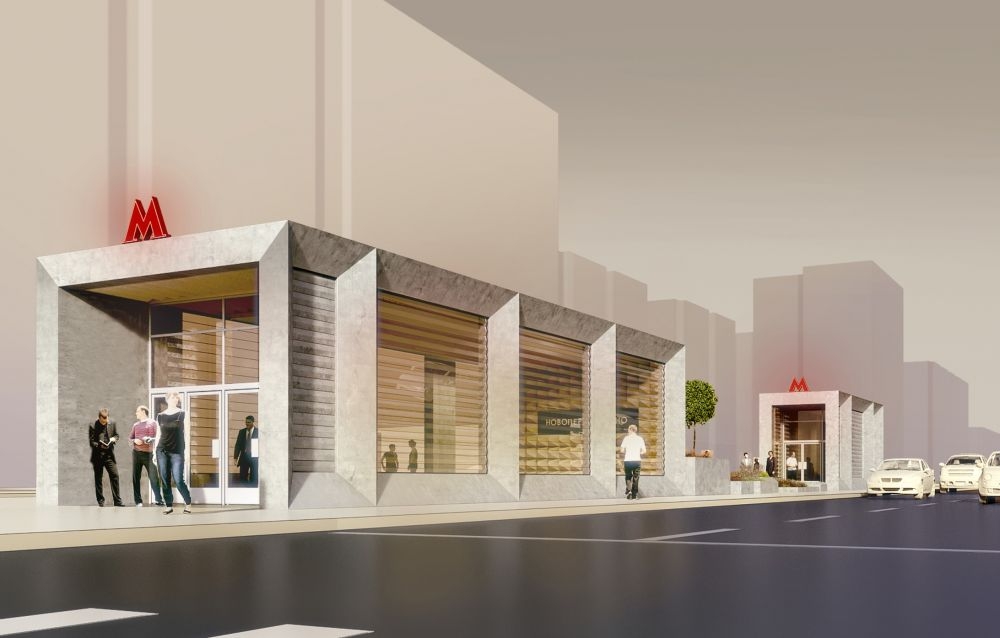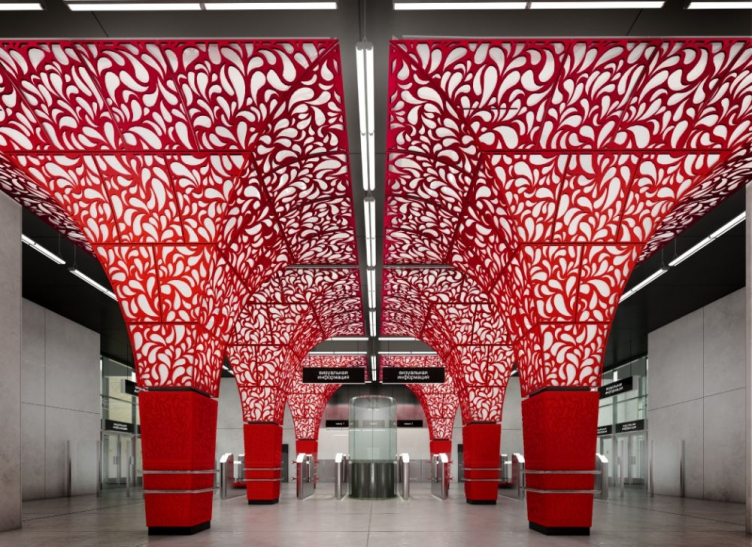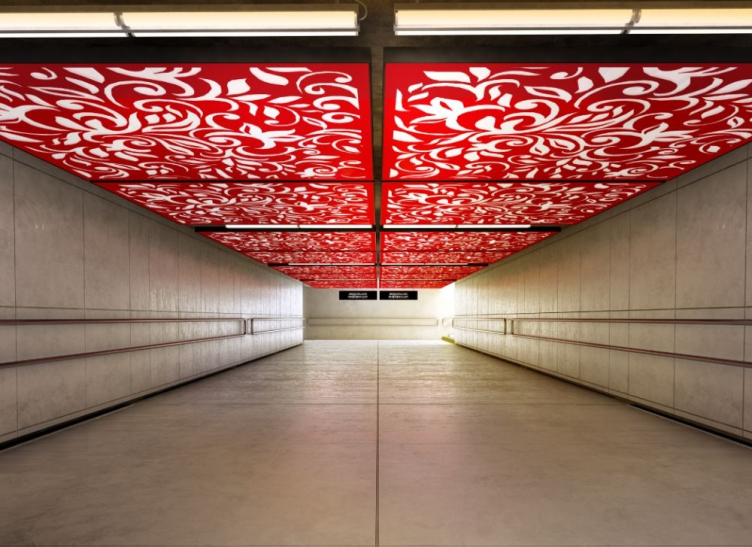"Solntsevo" station: music of the spheres

"Solntsevo" metro station. Location and plan of the exits. Image courtesy by the contest organizers.
The bright place-name (Solntsevo, "Town of the Sun" - translator's note) charmed literally all - at least all the finalists. In each of the projects, the main part is played by the sunlight - all the contestants peppered their proposals with the solar disks and glittering stars. Indeed: we do not always get the best weather around here, and even a hint at a sunny day is highly valued.
***
NEFA ARCHITECTS [NEFARESEARCH](Moscow, Russia)
The punctured walls of the entrance lobbies whose proportions remind us of the classic Moscow garages (only larger) - are meant to gather the sunlight together in a host of rays inside. Streaming from above, the rays of light penetrate even underground (figuratively, though) where the specs of light are imitated by the round lamps. The navigating light will be executed in the form of a glowing stripe in the semitransparent artificial stone.

Project of "Solntsevo" station © NEFA ARCHITECTS [NEFARESEARCH]

Project of "Solntsevo" station © NEFA ARCHITECTS [NEFARESEARCH]

Project of "Solntsevo" station © NEFA ARCHITECTS [NEFARESEARCH]
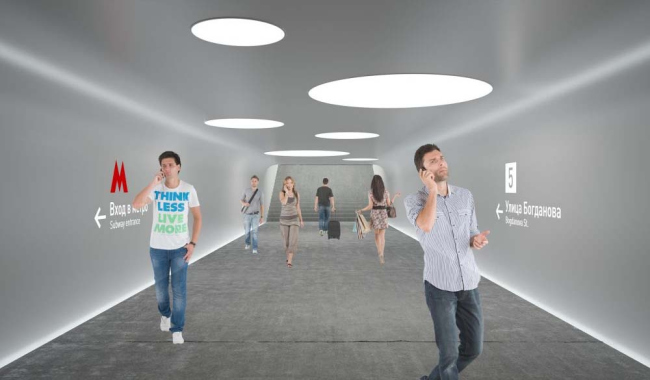
Project of "Solntsevo" station © NEFA ARCHITECTS [NEFARESEARCH]
***
Rhizome Group(Saint Petersburg, Russia)
The "sunny" name of the metro station prompted the authors to use predominantly bright colors, and only after that - the "solar disks". The vertical surfaces are faced with ceramic tiles of yellow and white colors, the paving pattern of the tiles made different at different places to liven up the atmosphere and create a more dynamic feel. The lighting consists of two lines of large "solar disks" hanging down from the ceiling. The central part of the platform is accentuated by a broad curvilinear band where various pieces of furniture can be placed that can not only be sat upon but also leaned on to. The authors also propose to pave the space between the pavilions with bright-colored tiles.
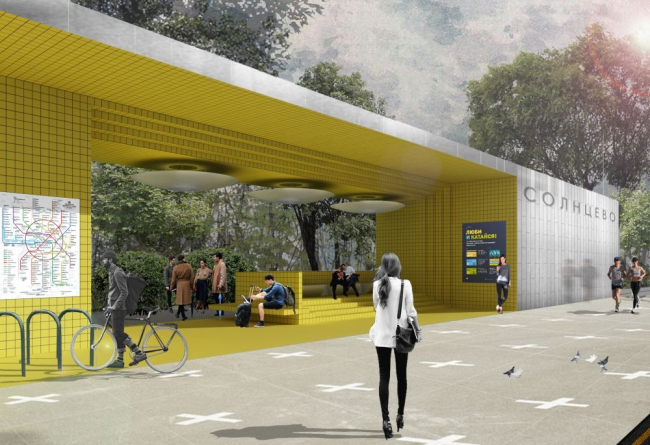
Project of "Solntsevo" station © Rhizome Group
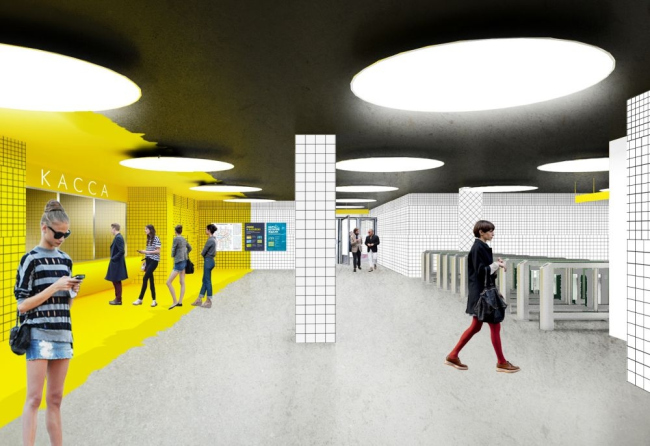
Project of "Solntsevo" station © Rhizome Group
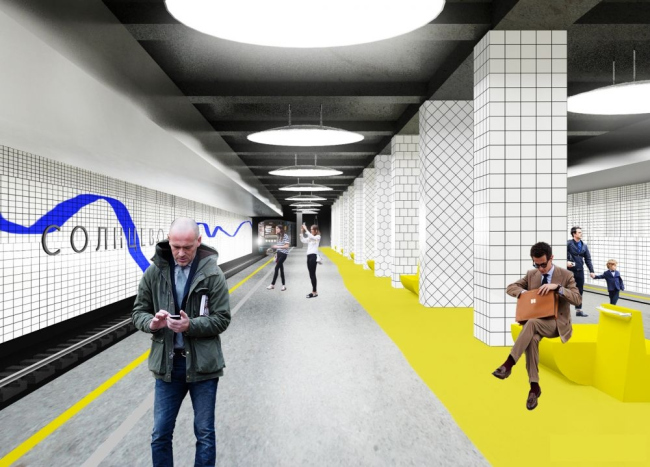
Project of "Solntsevo" station © Rhizome Group
***
Wall(Moscow, Russia)
Astronomy again: the station looks like planetarium that demonstrates a shooting star shower and the motion of heavenly bodies. In front of the station entrance, there is an art object that shows the trajectories of the planets of the solar system. The walls of the underpasses between the above-ground and underground parts are executed from opaque glass, one of the walls "bending" and forming a long bench. The platform is equipped with a wall with sliding doors matching the doors of the train cars (a solution familiar to many people by some train stations in Saint Petersburg). The glowing stripes on the walls looking like a snapshot of a starry sky in motion enhance the effect and make the passengers feel as if they are heavenly bodies tearing through space.

Project of "Solntsevo" station © Wall
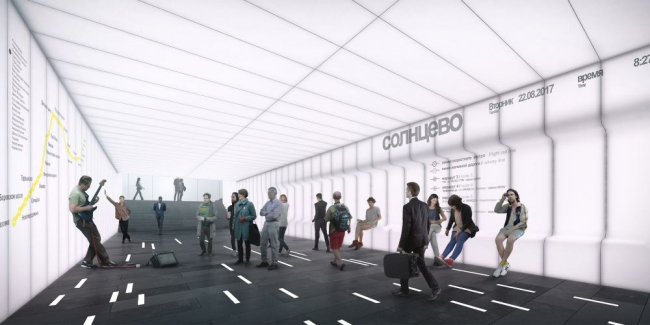
Project of "Solntsevo" station © Wall

Project of "Solntsevo" station © Wall
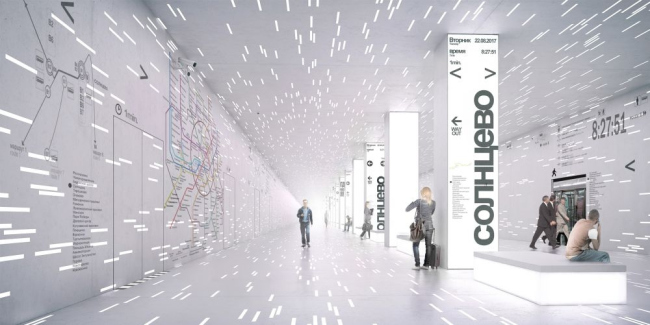
Project of "Solntsevo" station © Wall
***
Anton Barklyansky(Moscow, Russia)
In this project, the station looks like a cave from some computer game. The pillars look like stylized stalactites or like video footage of giant streams of white paint splashed onto a blue surface put on pause and then turned upside down. The result is a hall in which each of the pylons ends in a curvilinear "umbrella" awning that, due to their shape that is not quite regular, look as if they were chaotically placed. The umbrella awnings are to be found not only at the station - softening the borders between the above-ground and underground they also adorn the territory of the adjacent park.

Project of "Solntsevo" station © Anton Barklyansky

Project of "Solntsevo" station © Anton Barklyansky
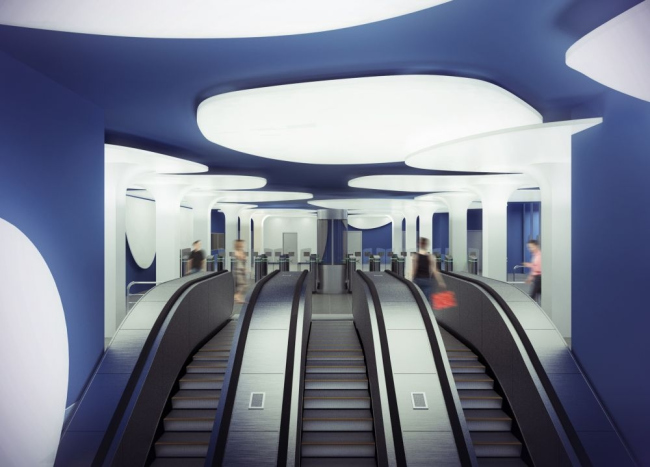
Project of "Solntsevo" station © Anton Barklyansky
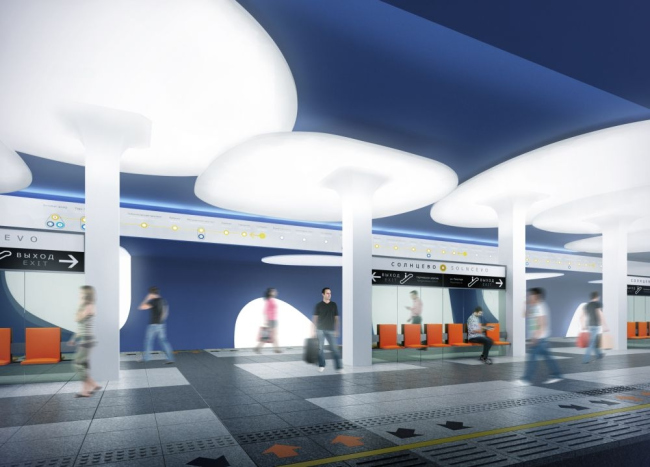
Project of "Solntsevo" station © Anton Barklyansky
***
Rosproject M(Saint Petersburg, Russia)
Cylindrical supports: slender at the top, positioned at different angles, they echo Moscow's ash trees; almost brutal at the bottom, they bleed into the spots of light visually piercing the surface of the ceiling. The sunlight - yes, the project is all about the sun again, there is no getting away from the place-name - is scattered all over the ceiling in small disks looking like stars or just sunlight dapples. In the underpasses, the lamps are gathered into thin lines, while the entrance pavilions, transparent and slender-legged, will emit a cozy light in the evenings. One way or another, the sun here takes on some "underground" quality - it shines from down under, not the other way around.

Project of "Solntsevo" station © Rosproject M

Project of "Solntsevo" station © Rosproject M
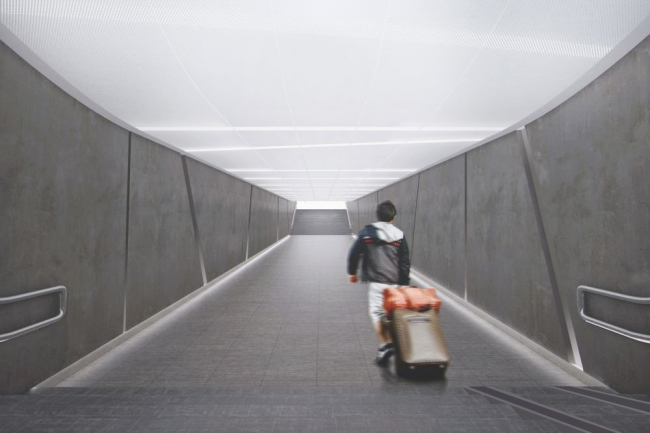
Project of "Solntsevo" station © Rosproject M
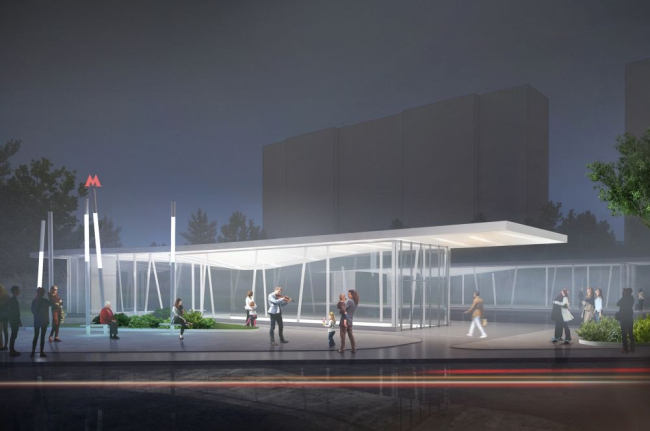
Project of "Solntsevo" station © Rosproject M
"Novoperedelkino" metro station
Since neither the place-name nor the surrounding scenery were suggestive of an obvious starting point for the authors, "Novoperedelkino" station got a multitude of different solutions, not united, as opposed to the lightened-up "Solntsevo", by some single theme. Rather, the architects meditated on the Russian identity in general portraying it as a concrete bunker standing amidst a deep forest, a mottled heraldic eagle, a multicolored ornamental fair, as well as a number of less "tell-tale" things - a set of acid colors or a white "kerchief" arrested in motion.
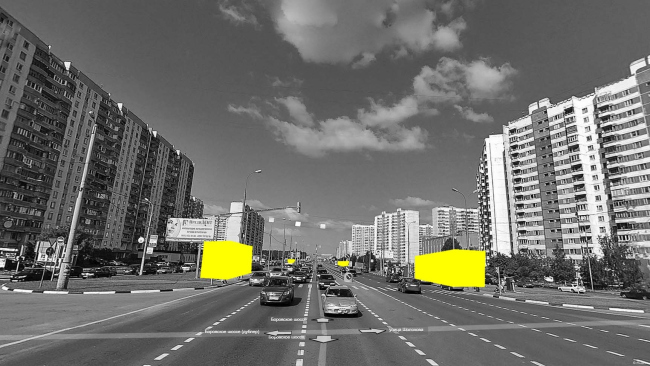
"Novoperedelkino" metro station. Location and plan of the exits. Image courtesy by the contest organizers.
***
FAS(t)(Moscow, Russia)
The idea of the project: "underground" forest. The station is underground but, with the help of glowing stripes bearing the images of trees, the architects achieve the effect of an open-air metro station (such as many stations at the Light-Blue line of Moscow Metro, only at those stations it is the train that is exposed to the sky, and this project imitates a live forest at the edges of the station). Everything is real except for the trees, - [UPD: The authors recently specified that, no, the forest is also going to be real. What they plan to do is gradually lower, down to the level of the roadway, the "green" park-ways that separate the main highway from the other roads, and plant them with shrubs and small trees, thus creating the effect of a mixed forest and the natural relief. The whole thing is separated from the roadway by a giant stained glass"]. By contrast with the trees, the space of the station is very "brutalist", dark-concrete, with exposed communications, the heaviness of the man-made machinery accentuated by the ethereal aspect of the pastoral forest. The movie-like quality of the concrete bunker, so alien to Moscow Metro, and so customary to any western subway, gets an interesting spin, though: the rough texture of the wall is accentuated by the side light whose beams, when needed, tear the ceiling or draw us into the tunnels of the underpasses.

Project of "Novoperedelkino" station © FAS(t)
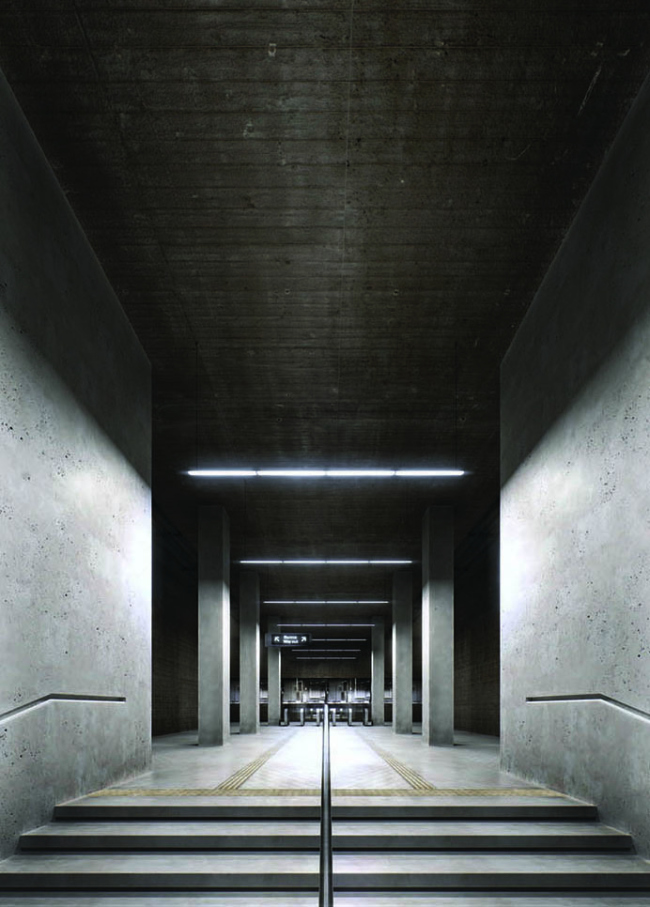
Project of "Novoperedelkino" station © FAS(t)
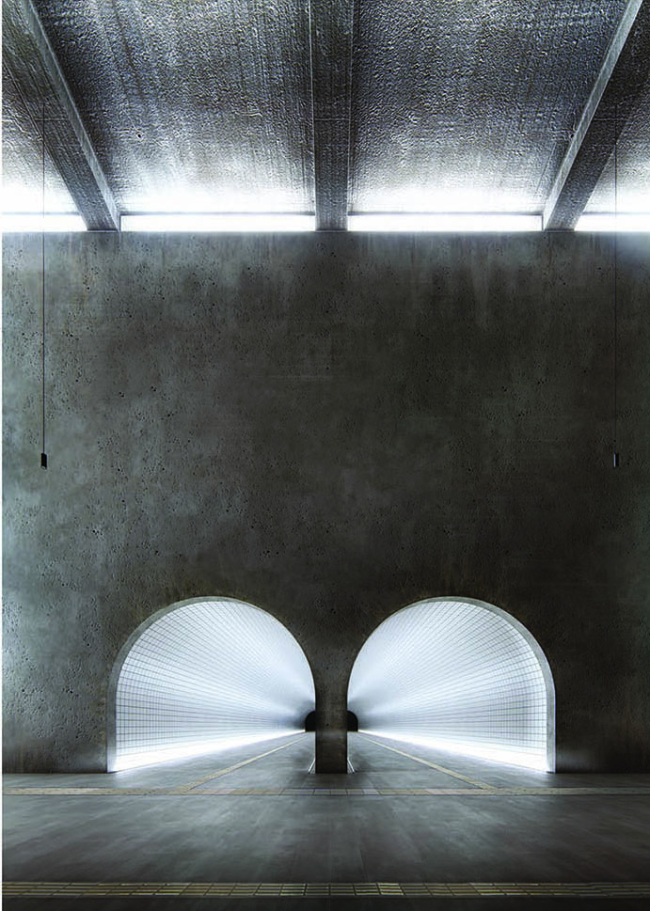
Project of "Novoperedelkino" station © FAS(t)
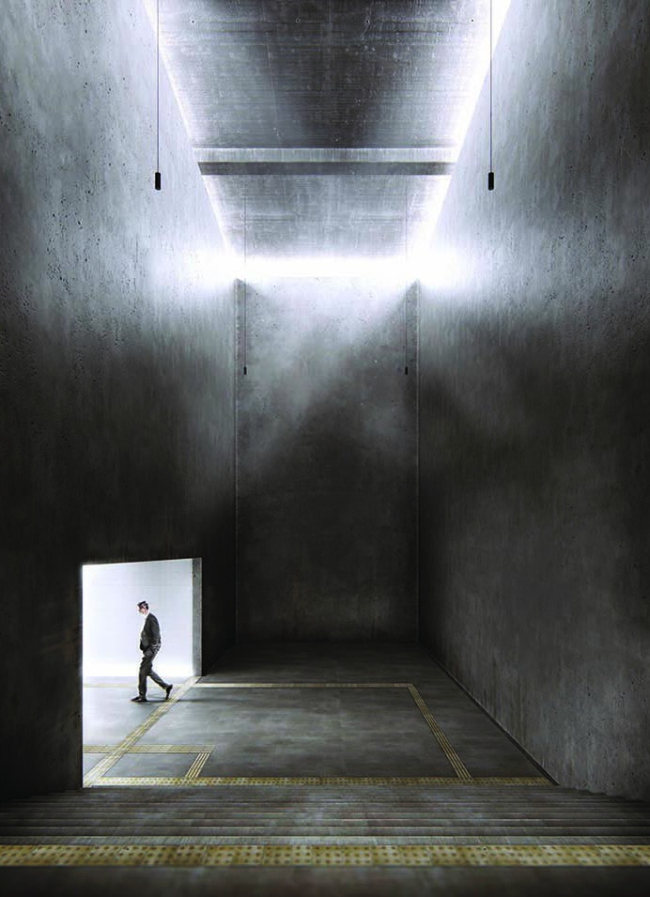
Project of "Novoperedelkino" station © FAS(t)
***
Gerber Architekten(Dortmund, Germany)
The project is based on one single beautiful plastic theme: a white pleated fan, whose large folds look more like silk than paper (looking even more like Corian), serves as a sculptural curvilinear ceiling that stretches over the platform; just before the station entrance, it gathers itself into a large column (something like "Kurskaya" metro station), and then tears to the surface almost like a scarf of a pilot of the 1930's: a white scarf from the black underground. The fan/scarf will be backlit with eye-friendly daylight electric lamps.
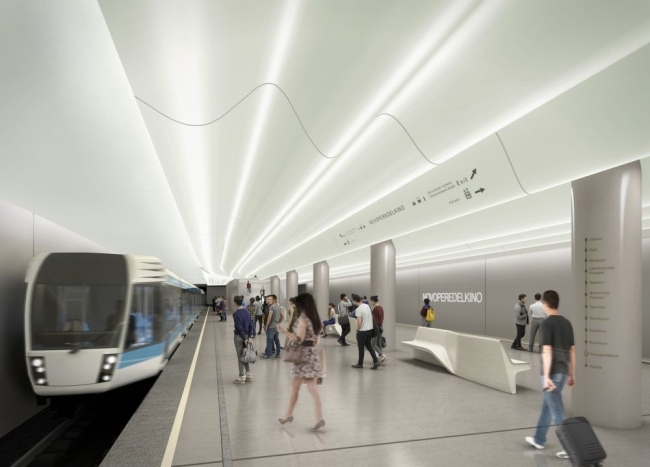
Project of "Novoperedelkino" station © Gerber Architekten
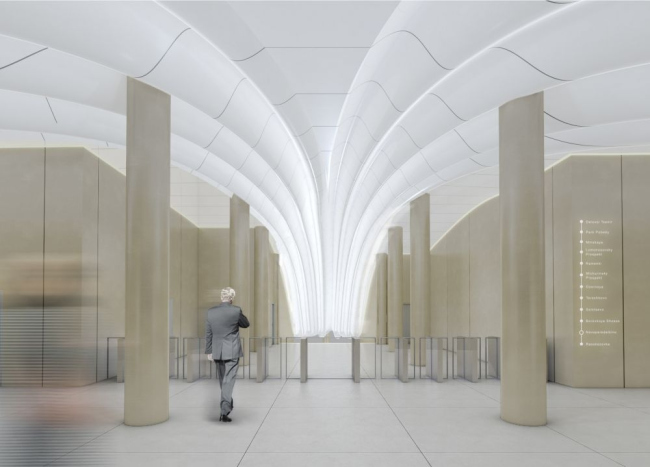
Project of "Novoperedelkino" station © Gerber Architekten
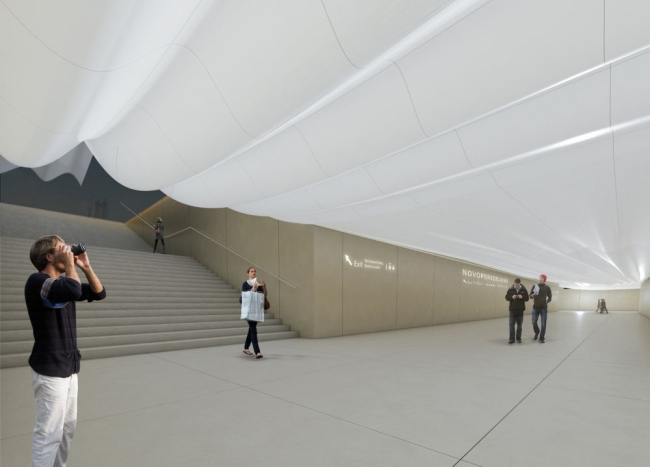
Project of "Novoperedelkino" station © Gerber Architekten
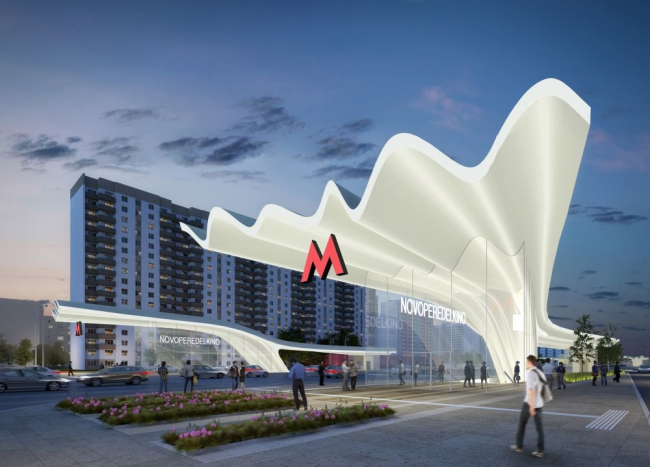
Project of "Novoperedelkino" station © Gerber Architekten
***
Boris Voskoboinikov Studio [NEFARESEARCH](Moscow, Russia)
The simple parallelepiped of the entrance pavilion is executed from the material that looks like a punctured breadboard or a honeycomb. The project is brimming with color and optimism; the bright luminescent light that usually brings the passengers down will be changed with the joyous palette of green, orange, and lilac colors. The walls of the underpass turn into an active navigation and information panel. The signal lines on the platform and the lines on the transportation map will be executed as plains of the printed board.
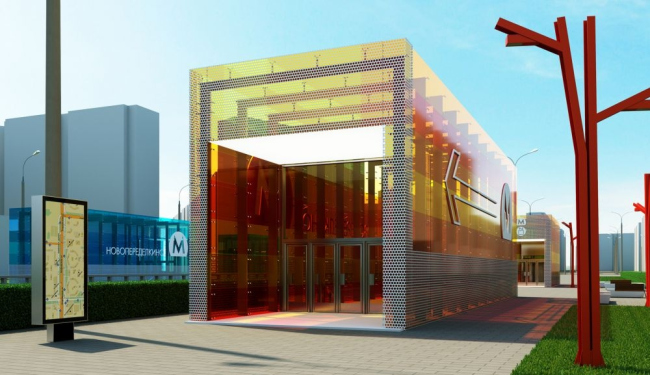
Project of "Novoperedelkino" station © Boris Voskoboinikov Studio [NEFARESEARCH]
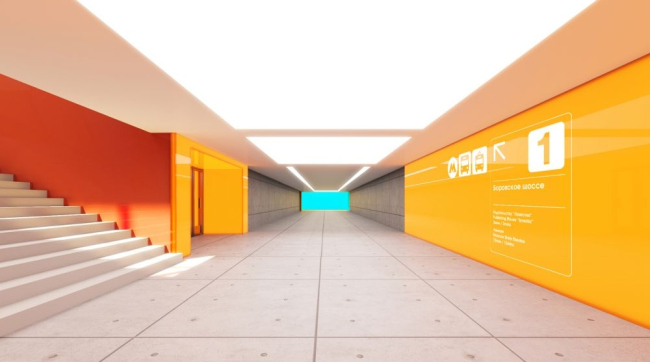
Project of "Novoperedelkino" station © Boris Voskoboinikov Studio [NEFARESEARCH]
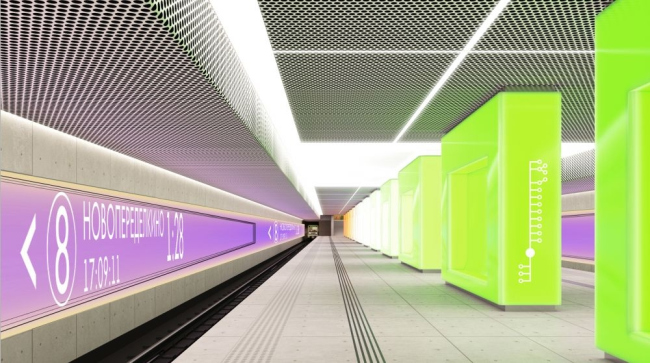
Project of "Novoperedelkino" station © Boris Voskoboinikov Studio [NEFARESEARCH]

Project of "Novoperedelkino" station © Boris Voskoboinikov Studio [NEFARESEARCH]
***
Palast Architekts
(Riga, Latvia)
The authors decided to bring to "Novoperedelkino" the fame of the world's quietest subway station. In order to achieve that, they propose to cover the station's walls and ceiling with innovative acoustically treated panels that will not let the sound waves reflect from the walls and create their jarring echo. For this same purpose, they considerably increased the wall surface - it is corrugated and at some places is made from diamond-pointed rustication to unobtrusively form something Byzantine or maybe just Empire-magnificent and heraldic. The large stone grille of the entrance entrance pavilion consists of bas-relief windows that complete the picture.

Project of "Novoperedelkino" station © Palast Architekts
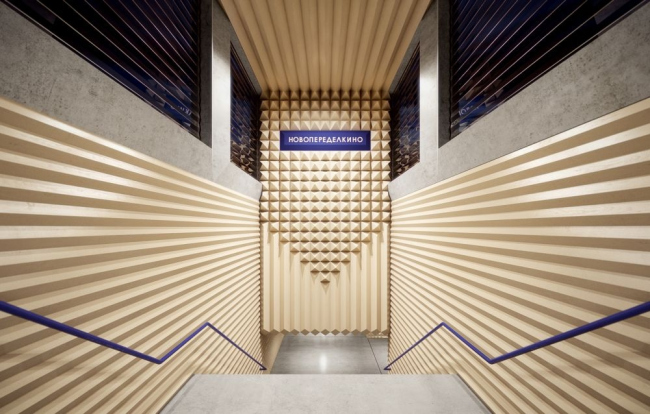
Project of "Novoperedelkino" station © Palast Architekts
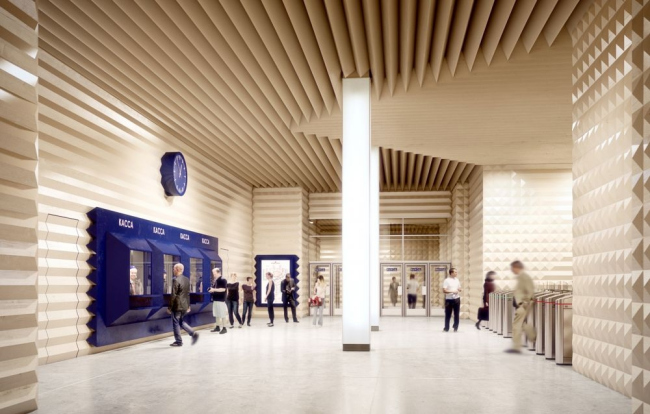
Project of "Novoperedelkino" station © Palast Architekts
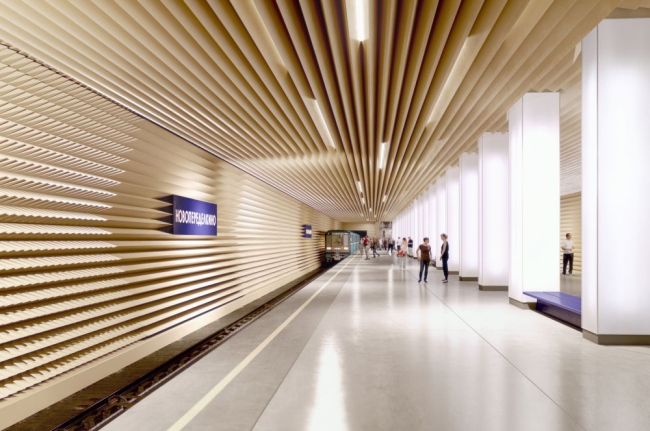
Project of "Novoperedelkino" station © Palast Architekts
***
Eugene Leonov(Riga, Latvia)
This project is about the Ancient Russ: the motifs of the adornment of Moscow's palaces and chambers, the "grass" (still reminiscent of the Kholuy paintings or even of the Sochi trademark Olympic drawings) pillars that grow wider at the top as if to support some stone vaults. In actuality, these "vaults" are lightboxes equipped with RGB-LED (light-emitting diodes) that can change the color of the light during the city celebrations.
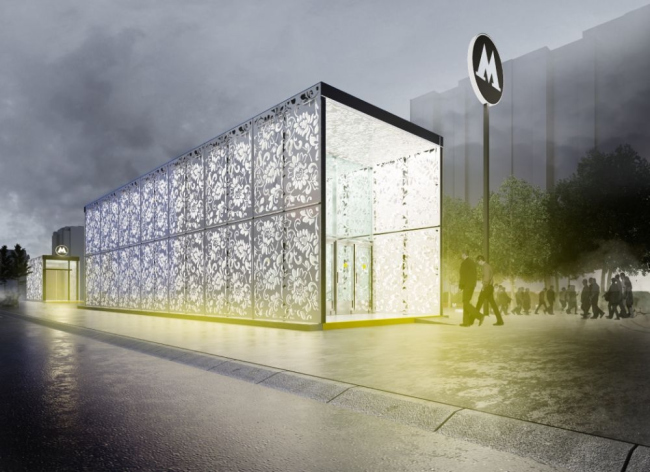
Project of "Novoperedelkino" station © Eugene Leonov

Project of "Novoperedelkino" station © Eugene Leonov
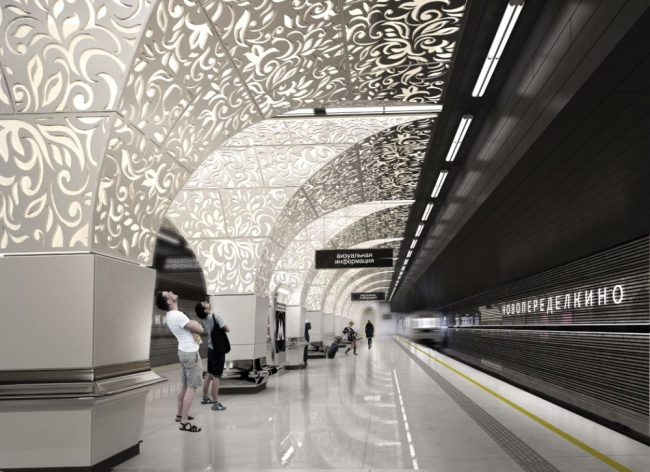
Project of "Novoperedelkino" station © Eugene Leonov

Project of "Novoperedelkino" station © Eugene Leonov
***
Totally, over 600 projects were submitted for the contest, but only 96 were considered by the judging panel as answering all the contest specifications ("Novoperedelkino - 46, "Solntsevo" - 50). Out of these, 22 projects were from foreign participants: Slovenia, Netherlands, Germany, India, France, Bulgaria, Spain, Cyprus, Great Britain, Canada, and Italy. Judging Panel:
- Marat Khusnullin, deputy mayor of Moscow for town planning issues (president of the judging panel);
- Andrew Bochkarev, chief of construction department of Moscow;
- Andrew Gnezdilov, the main architect of Scientific Research and Design Institute of General Plan of Moscow;
- Elena Gonzales, architectural reviewer, curator of exhibitions;
- Erken Kagarov, art director of Artemy Lebedev Studio;
- Olga Kosareva, co-founder of "Design-Lectorium";
- Sergey Kuznetsov, chief architect of Moscow;
- Konstantin Matveev, General director of JSC "Mosengproject";
- Aleksey Muratov, partner of "Strelka" Studio;
- Vladimir Plotkin, partner, founder, and chief architect of "Reserve" Studio;
- Elena Solovieva, leader of NPO-38 "Protected Historical Zones" of Scientific Research and Design Institute of General Plan of Moscow;
- Vasily Tsereteli, executive director of Moscow Museum of Modern Arts;
- Nikolai Shumakov, president of Moscow Architects Union, chief architect of Metrogiprotrans.
"Solntsevo" metro station. Location and plan of the exits. Image courtesy by the contest organizers.
Project of "Solntsevo" station © NEFA ARCHITECTS [NEFARESEARCH]
Project of "Solntsevo" station © NEFA ARCHITECTS [NEFARESEARCH]
Project of "Solntsevo" station © NEFA ARCHITECTS [NEFARESEARCH]
Project of "Solntsevo" station © NEFA ARCHITECTS [NEFARESEARCH]
Project of "Solntsevo" station © Rhizome Group
Project of "Solntsevo" station © Rhizome Group
Project of "Solntsevo" station © Rhizome Group
Project of "Solntsevo" station © Wall
Project of "Solntsevo" station © Wall
Project of "Solntsevo" station © Wall
Project of "Solntsevo" station © Wall
Project of "Solntsevo" station © Anton Barklyansky
Project of "Solntsevo" station © Anton Barklyansky
Project of "Solntsevo" station © Anton Barklyansky
Project of "Solntsevo" station © Anton Barklyansky
Project of "Solntsevo" station © Rosproject M
Project of "Solntsevo" station © Rosproject M
Project of "Solntsevo" station © Rosproject M
Project of "Solntsevo" station © Rosproject M
"Novoperedelkino" metro station. Location and plan of the exits. Image courtesy by the contest organizers.
Project of "Novoperedelkino" station © FAS(t)
Project of "Novoperedelkino" station © FAS(t)
Project of "Novoperedelkino" station © FAS(t)
Project of "Novoperedelkino" station © FAS(t)
Project of "Novoperedelkino" station © Gerber Architekten
Project of "Novoperedelkino" station © Gerber Architekten
Project of "Novoperedelkino" station © Gerber Architekten
Project of "Novoperedelkino" station © Gerber Architekten
Project of "Novoperedelkino" station © Boris Voskoboinikov Studio [NEFARESEARCH]
Project of "Novoperedelkino" station © Boris Voskoboinikov Studio [NEFARESEARCH]
Project of "Novoperedelkino" station © Boris Voskoboinikov Studio [NEFARESEARCH]
Project of "Novoperedelkino" station © Boris Voskoboinikov Studio [NEFARESEARCH]
Project of "Novoperedelkino" station © Palast Architekts
Project of "Novoperedelkino" station © Palast Architekts
Project of "Novoperedelkino" station © Palast Architekts
Project of "Novoperedelkino" station © Palast Architekts
Project of "Novoperedelkino" station © Eugene Leonov
Project of "Novoperedelkino" station © Eugene Leonov
Project of "Novoperedelkino" station © Eugene Leonov
Project of "Novoperedelkino" station © Eugene Leonov

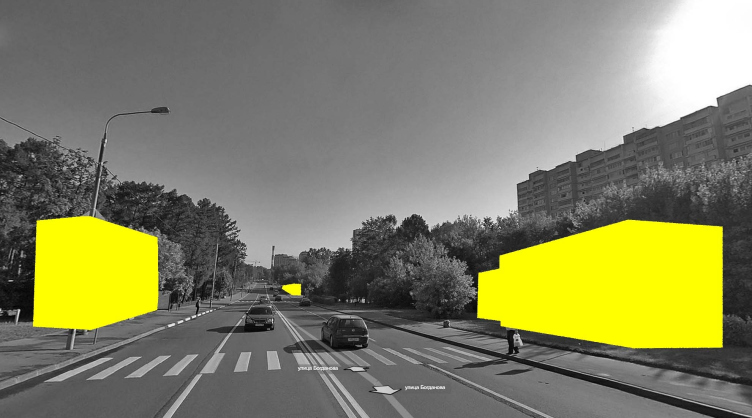

![Project of "Solntsevo" station © NEFA ARCHITECTS [NEFARESEARCH] zooming](http://i.archi.ru/i/752_541/169922.jpg)
![Project of "Solntsevo" station © NEFA ARCHITECTS [NEFARESEARCH] zooming](http://i.archi.ru/i/169925.jpg)
![Project of "Solntsevo" station © NEFA ARCHITECTS [NEFARESEARCH] zooming](http://i.archi.ru/i/169924.jpg)
![Project of "Solntsevo" station © NEFA ARCHITECTS [NEFARESEARCH] zooming](http://i.archi.ru/i/169923.jpg)



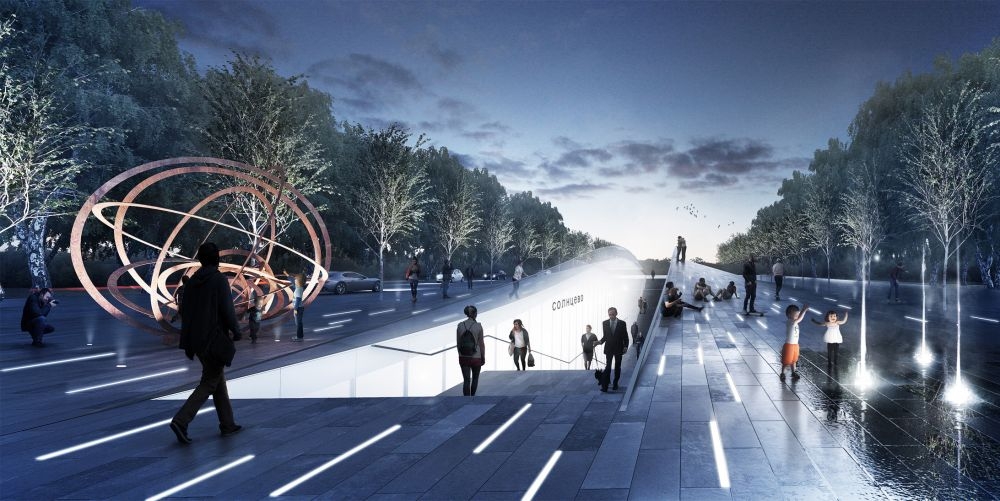

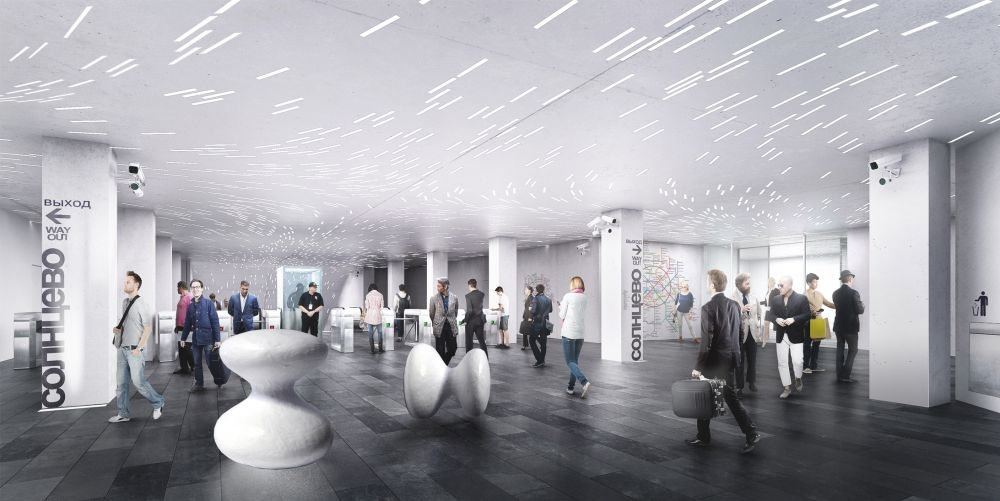


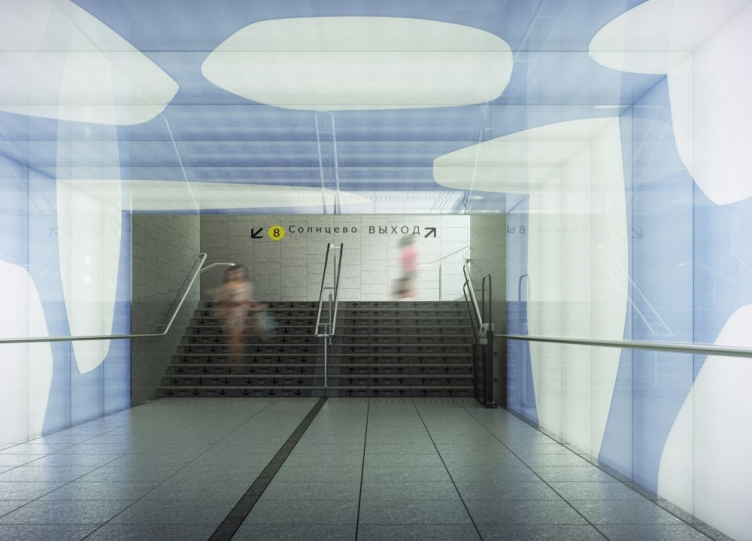


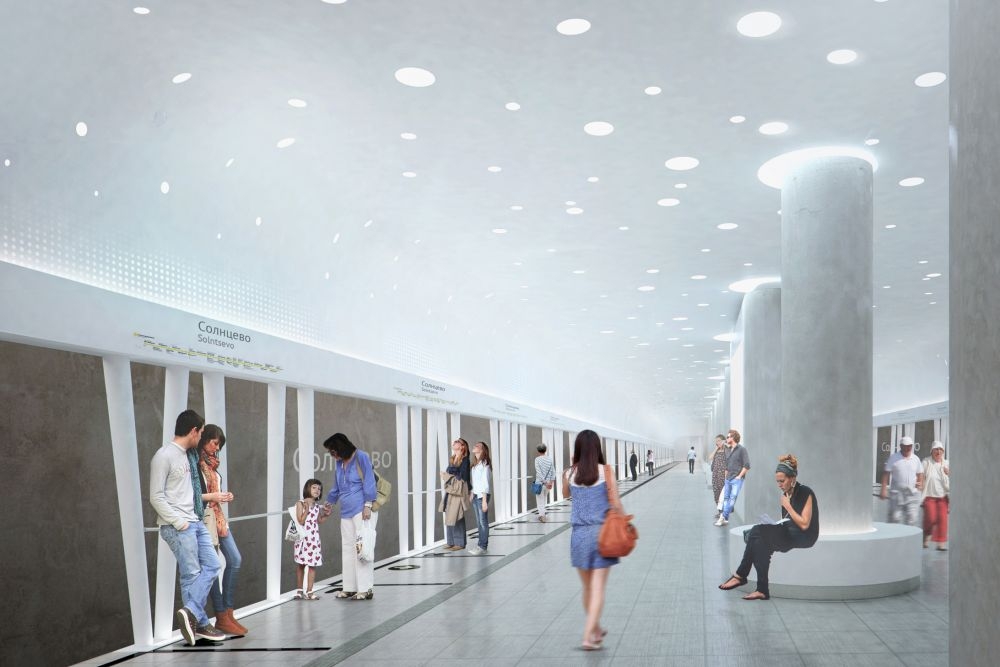




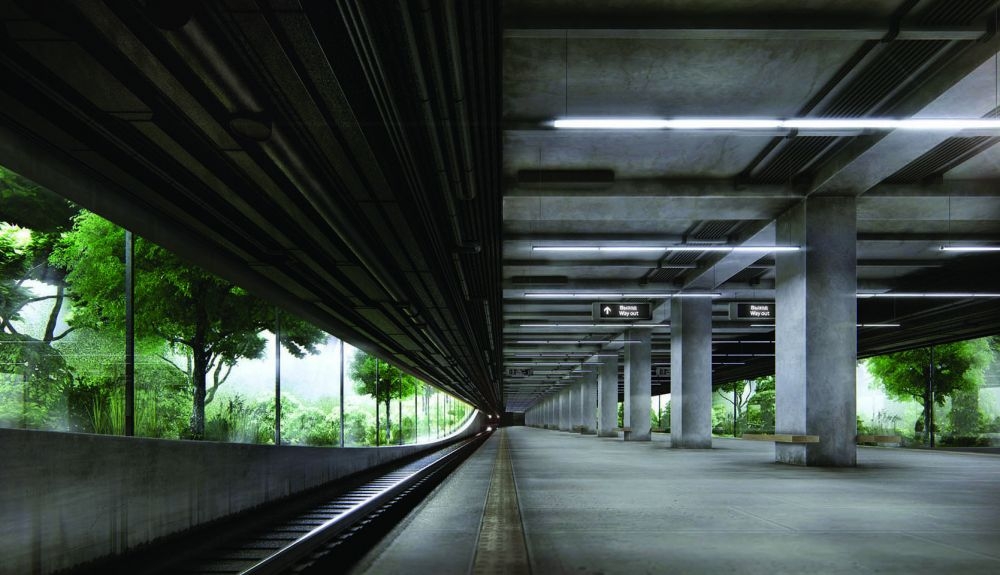







![Project of "Novoperedelkino" station © Boris Voskoboinikov Studio [NEFARESEARCH] zooming](http://i.archi.ru/i/169910.jpg)
![Project of "Novoperedelkino" station © Boris Voskoboinikov Studio [NEFARESEARCH] zooming](http://i.archi.ru/i/169911.jpg)
![Project of "Novoperedelkino" station © Boris Voskoboinikov Studio [NEFARESEARCH] zooming](http://i.archi.ru/i/169913.jpg)
![Project of "Novoperedelkino" station © Boris Voskoboinikov Studio [NEFARESEARCH] zooming](http://i.archi.ru/i/169912.jpg)
